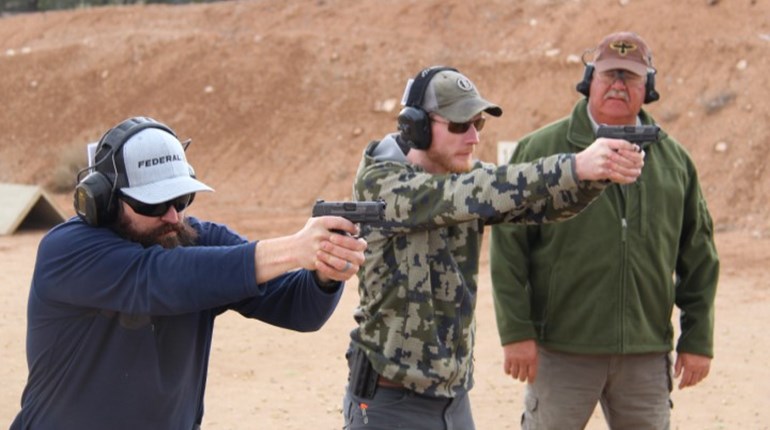
The Problem
Your experience level in shooting is what you would call in the area of intermediate to good. After a stint in the military where you enjoyed going to the range, you decided to continue shooting to maintain your proficiency with firearms.
The more you shoot, the more you have become interested in shooting accurately. The problem you have is trying to remember all the steps you were taught during your military training, especially the necessary steps to make a good shot happen consistently. The second problem you have is trying to implement those steps in the correct order, so you can shoot accurately.
You’ve seen some really good shooters make hitting their targets seem effortless, while it is a lot of work for you to do half as well. What’s their secret? There must be some formula you can use to shoot better than you do at present.
The Solution
This is a question I get in one form or another fairly regularly. Breaking it down to the epitome of simplicity, it is little more than muzzle management and trigger-finger discipline integrated into a repeatable system of stabilizing the muzzle on the target while simultaneously triggering the shot. Improvement comes from learning how to maintain minimal muzzle movement in relation to the target from the initial shooting position until the bullet exits the muzzle. This can take fractions of a second to several seconds for each shot, but it’s all relative to the accuracy required for the discipline you are shooting.
Conventional training—such as you would have received in the military—tends to over-complicate the shot-delivery process by teaching a step-by-step process that can include a dozen or more “must dos” for each shot fired. The problem is, by the time you remember to do all of those steps in preparation to shoot the shot, your brain is fried and your body is tired, which leaves you just wanting to get the shot off and hope for the best. It is common in conventional training to start at the ground and work up, leaving how you should use the sights and trigger to achieve optimal accuracy until last.
In reality, control of the trigger is the most important factor in achieving safety and success, followed closely by managing muzzle position. Certainly, there are many other factors that will help to put your shots where you want them, but none are as important as trigger-finger discipline and muzzle management.
You understand the only place the bullet comes out of the gun is the muzzle. If I were to hand you a loaded gun and told you to point the muzzle at a target and hold it as stable as you could, in whatever shooting position you felt was best, chances are you would orient yourself to the target with a minimum of muscle tension and probably hold your breath for a short period of time in an effort to be as still as possible. Your natural point-of-aim and hand/eye coordination will usually get the muzzle somewhere on or near the target. You most likely would be in an acceptable position to allow a pretty good shot on target. Sure, we could fine-tune that position to optimize your performance, but we didn’t have to build your shooting position from the ground up. In combat and in many types of competition, a shooting position is unlikely to be a picture-perfect shooting stance, but the best position to stabilize the muzzle on the target long enough for the bullet to exit.
The sights are there to fine-tune the position of the muzzle on the target. By aligning the iron sights or superimposing the crosshair or dot of an optic in the desired area of bullet impact, the muzzle is oriented to hit the target when the shot is fired.
The only other required action for a successful shot is to operate the trigger to fire the gun—without adding motion to the gun. A simple tip is to envision the trigger as being the gas pedal of a high-performance car that you want to accelerate rapidly without spinning the wheels. A smooth, fluid motion is what’s required to accomplish both tasks. Notice I didn’t mention slow or fast, just smooth and fluid.
Assuming from your previous training you understand sight picture and my description of trigger manipulation is within your grasp, your next step is to develop a plan of coordinating the two consistently in order to deliver accurate shots one after another. A method for doing this that has worked for me and my students with amazing results compounds the two essentials of stabilizing the muzzle on target and firing the shot by operating the trigger—without affecting the muzzle’s stability.
The process involves starting the trigger movement as the sights start to stabilize on target. During this stabilization and as the finger is moving the trigger rearward, a little mental processing and visualization releases the shot. By envisioning a connection between the trigger and front sight, dot or reticle, the trigger is pulled keeping the front sight centered in the rear sight notch or the optic centered on the target. This maintains visual and mental attention on the muzzle and the trigger through the firing of the shot.
Once you condition yourself to engage a target in this manner, it is likely all of the steps you were taught in the military will take on new meaning and will support your primary goal of triggering the shot without affecting the relationship of the muzzle to the target.
Using this method, you can fire accurate shots in minimum amounts of time, on demand. Not only does this improve your marksmanship, it also builds confidence in your ability to hit your target in less-than-ideal circumstances.






































